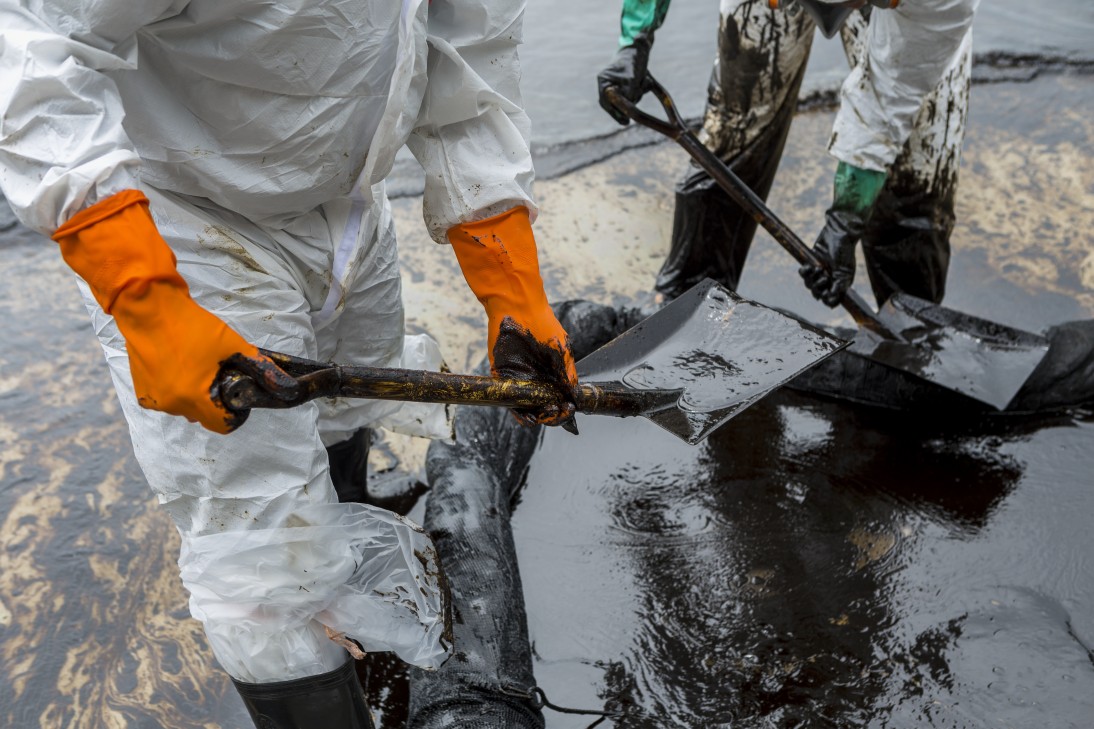On Saturday, October 2, 2021, an oil pipeline leaked more than 127,000 gallons of crude oil (3,111 barrels) into the Pacific Ocean near Orange County, California. By Monday morning, an oil slick had spread across an area of the ocean equivalent to roughly 8,320 acres or 13 miles. Classified as a major spill, the oil has not only added to a growing Pacific Ocean pollution problem, but it has also caused widespread damage to many tourist-friendly beaches and killed a wide range of marine and other wildlife.
No one knows precisely when the leak began. During the afternoon on Friday, October 1, residents and others in Orange County near the coast reported smelling foul odors in the air, including oil, diesel and raw meat. On Saturday, people swimming and sailing, including the mayor of Newport Beach, found themselves moving through oil slicks. By that evening, Huntington Beach residents and visitors observed oil washing onto beaches and polluting nearby marshes and wetlands.
On Saturday morning, Amplify Energy, a Houston oil company that manages oil platforms and a major pipeline in the Gulf of Santa Catalina, ordered their divers to investigate after alerting the United States Coast Guard about concerns from their inspectors who had found oil slicks during a line inspection. The Coast Guard filed an initial report at 9:10 a.m. It then reported the spill at 12:18 p.m. on its official Twitter account. At the time, it noted that the Coast Guard was responding to a report of an approximate 13-square-mile oil slick located roughly three miles from Newport Beach.
Initial Reassurances Created Confusion
On Saturday afternoon, local and state officials told the public that they didn’t feel the spill would impact beaches. They also felt confident that containment procedures would prevent any damage.
Yet, at that point, Amplify Energy suspected that a more than 17-mile-long pipeline located approximately four miles from the coastline and 80-to-100 feet below the surface of the water was the source of the spill. The pipeline connects to an oil platform called Elly located more than eight miles off shore. It aids in the transfer of crude oil from the underwater oil reservoir known as the Beta Field and two other platforms known as Ellen and Eureka” to Elly for processing to separate oil from water.
As a precaution, the company shut down the pipeline on Saturday night and suctioned as much of the oil as they could from it. That evening, officials from two beach areas, Huntington Beach and Newport Beach, informed the public that they were closing the beaches because they had learned that the spill would contaminate the coast.
Why Didn’t Officials Find the Source Faster?
Beta Operating Co., a subsidiary of Amplify Energy, operates all three platforms and the connecting pipeline. Although the company has monitoring systems in place, Elly receives crude oil from nearly 70 oil wells before it process the oil and sends it to the shore. Humans have to physically inspect every piece of pipeline on the ocean floor to find a leak once inspectors suspect that a company has missed one using standard monitoring systems and procedures. Additionally, approximately 20 other facilities exist in the region that can produce leaks.
Elly, Ellen and Eureka also process hundreds of thousands of gallons of crude oil. They’re massive structures that cover tens of thousand of square feet. Given the length of pipe involved and every potential source, it’s impossible to manually find a leak instantly. Even after the company’s divers found the leak Saturday and patched it, government officials learned on Sunday morning that the patch failed and the leak continued through the night.
As of Monday, officials opened an investigation into the possibility that an anchor from a ship transiting the area while entering or leaving a nearby port caused damage after it dragged over the pipeline. They’re also investigating Amplify Energy’s environmental safety record. Over the last few years, the company has received 72 environmental violation and safety citations with forced temporary shutdowns. In one incident, a platform released crude oil after someone bypassed a safety device.
Did Officials Suspect This Could Happen?
Transportation of oil through pipes in the ocean poses a high level of risk related to accidents and maintenance-related problems. Any number of events, from boat accidents to storms, can cause pipes to break. Saltwater can also corrode pipes and damage seals over time.
In 1969, a crude oil spill of approximately three million gallons off the coast of Santa Barbara resulted in a 35-mile long slick and decimated wildlife along the coast. In 1999, the Elly platform was involved in a 2,000-gallon leak from pipe corrosion and a leak-detection system that wasn’t calibrated properly. In 2015, another crude oil pipeline accident, a rupture, caused a spill of approximately 143,000 gallons near Refugio State Beach. These incidents don’t include the many oil and fuel spills in the region from tankers and cargo ships.
Director and Senior Attorney Miyoko Sakashita of the Center for Biological Diversity’s Oceans program explained to the media that she suspected that this might happen at any time. She referred to the platforms near Huntington Beach as aging time bombs that should have been decommissioned by now. The California Department of Fish and Wildlife even has an Office of Spill Prevention and Response.
What Locations Face the Most Impact?
Beyond Newport Beach and Huntington Beach, the oil has spread to Laguna Beach. Local officials have closed all beaches in that area. The slick has also progressed into the 25-acre Talbert Marsh, which is a reserve devoted to the protection of many species of birds and other animals and plants. The nearby Bolsa Chica Ecological Reserve is also at risk. Officials from Huntington Beach ordered the deployment of more than 2,000 feet of barriers near it to try to reduce the spread. They’re also using skimmers and other cleanup tools.
Dead fish and birds have already appeared in ocean waters in these areas. Officials expect to see a lot more marine animals become sick or die. Officials with the California Department of Fish and Wildlife have asked the public to report sightings of injured, struggling or dead wildlife to the University of California Davis Oiled Wildlife Care Network by phone at (877) 823-6923.
Cleanup teams face an uphill task with trying to remove the oil from the beaches, marshland and nearby waters. When a spill occurs, the oil not only maintains its liquid form. It also turn thick lengths, balls and patties of gelled oil and tar that stick to everything. Some of the oil balls are as large as softballs. Birds lose their ability to fly and monitor their temperatures. Various marine animals, including dolphins and whales, experience breathing difficulties that can kill them. Crude oil exposures can also harm humans and cause severe illness, including headache, rash and vomiting.
How Does This Spill Impact Tourism?
Amplify Energy claims that it has insurance to cover cleanup. The company’s spokespeople haven’t addressed the long-term economic costs. The COVID-29 pandemic has greatly reduced the volume of tourists to the region, which has had a negative impact on local economies. Beach shutdowns have worsened the region’s economic woes. Officials expect the shutdowns to last for weeks.
The event also forced commercial and recreational fishermen to go elsewhere. It caused the shutdown of the last day of the Pacific Airshow, which is a three-day event that normally attracts thousands of visitors and generates more than $70 million in revenues with flyovers by various military and flight demonstration squads.






